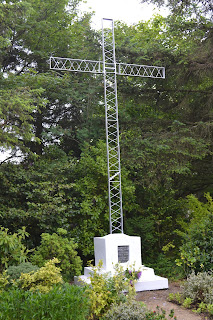Penyberth (pictured in the engraving above) was a farmhouse at Penrhos which had been
the home to generations of patrons of poets, but it was destroyed in 1936 in
order to build a training camp and aerodrome for the RAF. Known to opponents as
the “ bombing school” (in Welsh, yr ysgol fomio), this was opposed by
many in Wales but the Government ignored all representations. In protest at
this a workmen's shed at the site was the target on 8 September 1936 of an
arson attack by three of the leaders of Plaid Cymru, Saunders Lewis, Lewis
Valentine, and D. J. Williams. The jury at their first trial held at Caernarfon
failed to agree on a verdict, so the case was transferred to another court and
a second trial was held on 9 January 1937 at the Old Bailey, London, at which
they were found guilty and jailed in Wormwood Scrubs prison. When they were
released on 27 August 1937 (a year before the Munich settlement) a crowd of
over 15,000 gathered in Caernarfon to welcome them back to Wales. Saunders
Lewis is regarded as a central literary figure in 20th century Wales
and was a founder member of Plaid Cymru which took a pacifist stance in World
War 2.
Though this was a sideshow in pre war rearmament, this incident is known in the Welsh language as Llosgi'r ysgol fomio ("the burning of the bombing school") or Tân yn Llŷn ("Fire in Llŷn"), and has attained iconic status in Welsh nationalist circles. It resurfaced recently when sections of Plaid Cymru, now a partner in government in Wales, refused to welcome the new tri-service Defence Training campus at St Athan in the Vale of Glamorgan which is scheduled to create 10,500 jobs. RAF Penrhos survives as a single strip civilian airfield and is today the site of the annual Wakestock contemporary music festival and home to the Penrhos home for Polish refugees, one of the last remaining WW2 displaced persons camps.






No comments:
Post a Comment